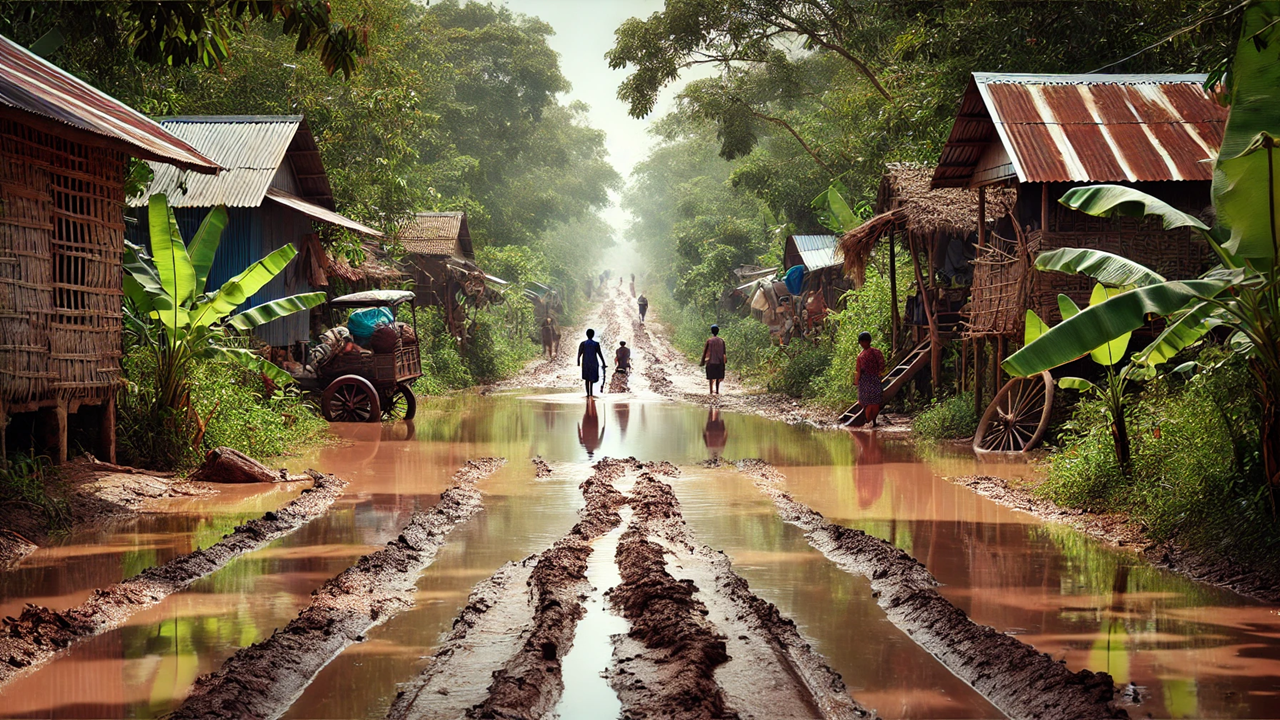Resilient Roads: Cambodia’s Strategy to Safeguard Development Against Floods
Cambodia’s rural roads are a vital part of its infrastructure but are increasingly at risk due to climate change and flooding. The World Bank’s report, Cambodia: Geospatial Analysis for Resilient Road Accessibility for Human Development and Logistic Supply, offers a data-driven framework for prioritizing road investments to enhance resilience. Targeted interventions such as improved drainage, road reinforcement, and bridge upgrades in vulnerable regions are critical to maintaining access to essential services and supporting economic development.

Cambodia’s Lifeline at Risk: Rural Roads and Climate Change
Cambodia’s rural road network, a critical artery for millions of people, is under growing threat from the increasing impacts of climate change. In a country where over 79% of the population lives in rural areas, roads are essential to accessing education, healthcare, jobs, and markets. However, with 90% of these roads unpaved and highly vulnerable to seasonal flooding, the need for climate-resilient infrastructure has never been more pressing.
The recently published report titled Cambodia: Geospatial Analysis for Resilient Road Accessibility for Human Development and Logistic Supply provides an in-depth analysis of how rural roads are exposed to climate risks, particularly floods, and offers a strategic framework for prioritizing investments to make these roads more resilient. The World Bank-backed report highlights both the urgency and the opportunity for Cambodia to safeguard its development goals by improving its road infrastructure.
Rural Roads: The Backbone of Cambodian Development
Cambodia’s rural roads cover over 47,000 km, forming 75% of the country’s entire road network. For the majority of the population, these roads are lifelines, connecting them to essential services like schools, hospitals, and markets. Yet, due to the country’s geographical location in the flood-prone Mekong River and Tonle Sap basins, these roads are particularly susceptible to the impacts of climate change.
In October 2020, extreme floods caused by heavy rains disrupted over 1,400 km of rural roads, highlighting just how vulnerable Cambodia’s infrastructure is to climate events. This disruption had severe consequences for rural communities, cutting off access to essential services and halting the flow of goods, including agricultural products crucial for both local markets and international trade.
According to the report, without substantial intervention, the growing intensity and frequency of floods due to climate change could worsen these vulnerabilities, further isolating rural communities and stalling economic development.
A Strategic Framework for Resilient Roads
The report presents a comprehensive framework to assist Cambodia’s Ministry of Rural Development (MRD) in prioritizing its investments in rural roads. Using geospatial models, the framework identifies the most critical roads that require urgent interventions based on their vulnerability to floods and their importance for human development and logistics.
Two core models were used in the analysis: the Flood Disruption Model and the Logistic Supply Chain Model. These models assess the impact of a 50-year flood scenario on road accessibility, revealing which roads are vital for keeping communities connected to services like healthcare, education, and employment, as well as maintaining the flow of agricultural products to markets.
The report introduces six key indicators, grouped into three development lenses,
Inclusiveness: Focuses on poverty reduction by evaluating how many poor communities rely on each road.
Human Development: Measures the importance of roads in providing access to schools, hospitals, and employment opportunities.
Logistic Supply: Assesses how rural roads contribute to agricultural markets and logistics corridors for domestic consumption and international trade.
By combining these indicators, the framework generates a “Road Criticality Score” for each commune, helping the MRD prioritize where investments will have the most impact in terms of reducing flood vulnerability and supporting socio-economic development.
Urgent Interventions: Where to Begin?
The report emphasizes the importance of targeted interventions, particularly in flood-prone communes such as Battambang, Prey Veng, and Kampong Thom. These regions face both high levels of poverty and frequent flood disruptions, making them priorities for road improvements. The report recommends three main types of interventions,
Improving Drainage: Enhancing road drainage systems is crucial to mitigate the impact of heavy rains, reducing the number of people cut off from hospitals, schools, and markets during floods.
Reinforcing Road Surfaces: Strengthening the road surface can prevent damage from waterlogging and erosion, making roads passable even during extreme weather events.
Upgrading Bridges: While less impactful than drainage improvements, upgrading bridges can play a key role in maintaining connectivity during floods.
These interventions are expected to have a significant impact. For example, improved drainage in Battambang could restore access to hospitals for 32% of residents during floods. However, the report also acknowledges that certain regions, such as Prey Veng, will require more comprehensive infrastructure upgrades, as the intensity of floods in these areas would overwhelm simpler drainage improvements.
A Way Forward: Investing in Cambodia’s Future
Cambodia: Geospatial Analysis for Resilient Road Accessibility for Human Development and Logistic Supply report provides a clear message: strategic investments in road infrastructure are essential to Cambodia’s development. The framework it presents allows decision-makers to use data-driven insights to direct resources where they are needed most, ensuring that rural roads can withstand the growing threat of climate change.
While the report acknowledges data limitations and the need for field observations to complement its findings, it offers a robust starting point for creating a more resilient road network. By prioritizing critical rural roads, Cambodia can not only protect its communities from climate disasters but also strengthen its economy by ensuring that essential services and supply chains remain intact.
As Cambodia continues to develop, building resilience in its rural road infrastructure will be key to maintaining progress in human development, poverty reduction, and economic growth.
- FIRST PUBLISHED IN:
- Devdiscourse
ALSO READ
Wildfires Rage in Los Angeles: A Climate Change Crisis
Global Temperatures Soar: Climate Change at a Critical Juncture
Climate Change's Toll: A Record $140 Billion in Insured Losses in 2024
Reviving Los Angeles: Resilient Urban Forests in the Face of Climate Change
US Delegation Engages with Chennai on Water Challenges and Climate Change










